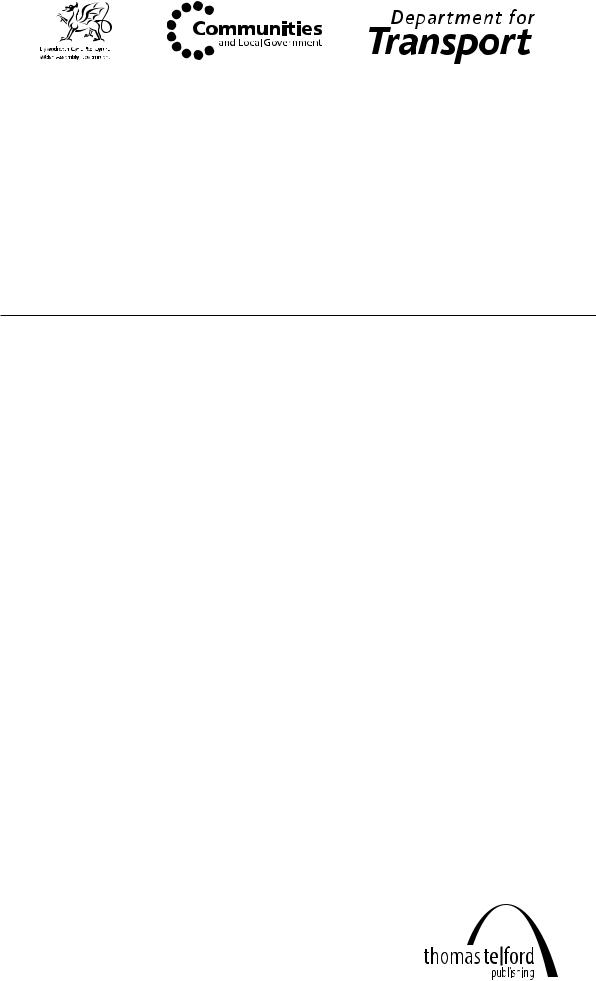

Manual for Streets

ManualforStreets

Published by Thomas Telford Publishing, Thomas Telford Ltd, 1 Heron Quay, London E14 4JD. www.thomastelford.com
Distributors for Thomas Telford books are
USA: ASCE Press, 1801 Alexander Bell Drive, Reston, VA 20191-4400, USA
Japan: Maruzen Co. Ltd, Book Department, 3–10 Nihonbashi 2-chome, Chuo-ku, Tokyo 103
Australia: DA Books and Journals, 648 Whitehorse Road, Mitcham 3132, Victoria
First published 2007
Published for the Department for Transport under licence from the Controller of Her Majesty’s Stationery Office
© Queen’s Printer and Controller of HMSO, 2007
Copyright in the typographical arrangement and design rests with the Queen’s Printer and Controller of HMSO.
This publication (excluding logos) may be reproduced free of charge in any format or medium for non-commercial research, private study or for circulation within an organisation. This is subject to it being reproduced accurately and not used in a misleading context. The copyright of the material must be acknowledged and the title and publisher specified.
This publication is value added material and as such is not subject to the Public Sector Information Click-Use Licence System.
For any other use of this material apply for a Value Added Click-Use Licence at www.opsi.gov.uk or write to the Licensing Division,
Office of Public Sector Information, St Clements House, 2–16 Colegate, Norwich NR3 1BQ. Fax: 01603 723000 or e-mail: licensing@opsi.x.gsi.gov.uk.
A catalogue record for this book is available from the British Library
ISBN: 978-0-7277-3501-0
This book is published on the understanding that the authors are solely responsible for the statements made and opinions expressed in it and that its publication does not necessarily imply that such statements and/or opinions are or reflect the views or opinions of the publishers. While every effort has been made to ensure that the statements made and the opinions expressed in this publication provide a safe and accurate guide, no liability
or responsibility can be accepted in this respect by the authors or publishers.
Printed and bound in Great Britain by Maurice Payne Colourprint Limited using material containing at least 75% recycled fibre.
Ordnance Survey mapping
All mapping is reproduced from Ordnance Survey material with the permission of Ordnance Survey on behalf of the Controller of
Her Majesty’s Stationery Office © Crown copyright. Unauthorised reproduction infringes Crown copyright and may lead to prosecution or civil proceedings. Department for Transport 100039241, 2007.
Cover image©Countryside Properties. Scheme designed by MDA

Contents
|
Foreword |
6 |
|
|
|
|
|
||
|
Preface |
7 |
|
|
|
|
|
|
|
|
|
|
|
|
|
|
|||
Section A |
1 |
Introduction |
10 |
|
|
|
|
||
|
|
|
|
||||||
Context |
2 |
Streets in context |
14 |
|
|
|
|||
|
|
|
|||||||
and |
|
|
|
||||||
process |
3 |
The design process - from policy to implementation 22 |
|
||||||
|
|||||||||
|
|
||||||||
Section B |
4 |
Layout and connectivity |
40 |
|
|
||||
|
|
||||||||
Design |
5 |
Quality places |
50 |
|
|
|
|
||
|
|
|
|
||||||
principles |
|
|
|
|
|||||
Section C |
6 |
Street users’ needs |
62 |
|
|
|
|||
|
|
|
|||||||
Detailed |
7 |
Street geometry 78 |
|
|
|
||||
|
|
|
|||||||
design |
|
|
|
||||||
issues |
8 |
Parking |
98 |
|
|
|
|
|
|
|
|
|
|
|
|||||
|
|
|
|
|
|
||||
|
9 |
Traffic signs and markings |
114 |
|
|
||||
|
|
|
|||||||
|
10 |
Street furniture and street lighting |
120 |
|
|||||
|
|
||||||||
|
11 |
Materials, adoption and maintenance |
126 |
|
|||||
|
|
||||||||
|
Index |
138 |
|
|
|
|
|
|
|
|
|
|
|
|
|
|
|||

Acknowledgements
Project team
Manual for Streets was produced by a team led by consultants WSP, with Llewelyn Davies Yeang (LDY), Phil Jones Associates (PJA) and TRL Limited on behalf of the Department for Transport, and Communities and Local Government.
The core team comprised (all lists in alphabetical order):
•Annabel Bradbury (TRL)
•Andrew Cameron (WSP)
•Ben Castell (LDY)
•Phil Jones (PJA)
•Tim Pharoah (LDY),
•Stuart Reid (TRL)
•Alan Young – Project Manager, (WSP)
With additional research and assistance by:
Sam Carman (WSP), Tom Ewings (TRL), Una McGaughrin (LDY) Peter O’Brien (LDY), Ross Paradise (TRL), Christianne Strubbe (Hampshire County Council), Iain York (TRL)
Graphic design by Llewelyn Davies Yeang (Ros Shakibi, Ting LamTang and Thanh Tung Uong, with artwork by Alexandra Steed) and overseen by
Ela Ginalska (Department for Transport)
Steering group
The Project Steering Group included:
Bob Bennett (Planning Officers Society), Edward Chorlton (Devon County Council), Vince Christie (Local Government Association), Wayne Duerden (Department for Transport) Louise Duggan (Commission for Architecture and the Built Environment), Ray Farrow (Home Builders’ Federation)
George Hazel (Urban Design Alliance), Ed Hobson (Commission for Architecture and the Built Environment), Gereint Killa (Department for Transport), Grahame Lawson (Disabled Persons Transport Advisory Committee), Spencer Palmer (Department for
Transport), John Smart (Institution of Highways and Transportation), Larry Townsend (Communities and Local Government),
Polly Turton (Commission for Architecture and the Built Environment), David Williams (Department for Transport), Mario Wolf (Communities and Local Government), Philip Wright (Health & Safety Executive)
Sounding board
Further advice was received from an invited Sounding Board consisting of:
Tony Aston (Guide Dogs for the Blind Association), David Balcombe (Essex County Council), Peter Barker (Guide Dogs for the Blind Association), Richard Button (Colchester Borough Council)
Jo Cleary (Friends of the Lake District), Meredith Evans (Borough of Telford & Wrekin Council), Tom Franklin (Living Streets),
Jenny Frew (English Heritage), Stephen Hardy (Dorset County Council), Richard Hebditch (Living Streets), Ian Howes (Colchester Borough Council), Andrew Linfoot (Halcrow), Peter Lipman (Sustrans), Ciaran McKeon (DublinTransport Office), Elizabeth Moon, (Essex County Council), Nelia Parmaklieva (Colchester Borough Council), Mark Sackett (RPS), Paul Sheard (Leicestershire
County Council), Alex Sully (Cycling England), Carol Thomas (Guide Dogs for the Blind Association), Andy Yeomanson (Leicestershire County Council), Emily Walsh (Solihull Metropolitan Borough Council), Leon Yates (London Borough of Lewisham)
Additional consultation and advice
Additional consultation took place with the following:
Mark Ainsworth (George Wimpey), John Barrell (Jacobs Consultancy), Terry Brown (GMW Architects), Hywel Butts (Welsh Assembly Government), David Coatham (Institution of Lighting Engineers), Mike Darwin (Leeds City Council), Adrian Lord (Arup /
Cycling England), Kevin Pearson (Avon Fire & Rescue Service), Michael Powis (Nottinghamshire Police), Gary Kemp (Disabled Persons Transport Advisory Committee), Malcolm Lister (London Borough of Hounslow)
In addition to those already listed, substantial comments on drafts of the manual were received from:
Duncan Barratt (West Sussex County Council), Neil Benison (Warwickshire County Council), Daniel Black (Sustrans), Rob Carmen (Medway Council), Greg Devine
(Surrey County Council), John Emslie (MVA Consultancy), Heather Evans (Cyclists’ Touring Club), David Groves (Cornwall County Council), Steve Mead (Derbyshire County Council), Christine Robinson (Essex County Council), Mick Sankus (Medway Council), Mike Schneider (North Somerset Borough Council), Graham Paul Smith (Oxford Brookes University), Fiona Webb (Mid Bedfordshire District Council), Bob White (Kent County Council)
Case studies
A number of case studies were investigated in the compilation if the Manual. These are listed below, along with the individuals who provided assistance:
•Beaulieu Park, Chelmsford:
Sarah Hill-Sanders, Chelmsford Borough Council Chris Robinson, Essex County Council
•Charlton Down, Dorset:
Stephen Hardy, Dorset County Council Ian Madgwick, Dorset County Council
•Crown Street, Glasgow:
Elaine Murray, Glasgow City Council Mic Ralph, Glasgow City Council Stephen Rigg, CZWG Architects
•Darwin Park, Lichfield:
Steve Clarke, Staffordshire County Council Ian Thompson, Lichfield District Council
•Hulme, Manchester:
Kevin Gillham, Manchester City Council Brian Kerridge, Manchester City Council
•Limehouse Fields, Tower Hamlets:
Angelina Eke, Tower Hamlets Borough Council John Hilder, Tower Hamlets Borough Council
•New Hall, Harlow:
Alex Cochrane, Roger Evans Associates Keith Lawson, Essex County Council Mriganka Saxena, Roger Evans Associates
•Pirelli site, Eastleigh:
Dave Francis, Eastleigh Borough Council Eric Reed, Eastleigh Borough Council
•Queen Elizabeth Park, Guildford:
David Barton, Guildford Borough Council David Taylor, Surrey County Council
•Staithes South Bank, Gateshead: Alastair Andrew, Gateshead Council Andy Szandrowski, Gateshead Council
|
Manual for Streets |

Status and application
Manual for Streets (MfS) supersedes Design Bulletin 32 and its companion guide Places, Streets and Movement, which are now withdrawn in England and Wales. It complements
Planning Policy Statement 3: Housing and
Planning Policy Wales. MfS comprises technical guidance and does not set out any new policy or legal requirements.
MfS focuses on lightly-trafficked residential streets, but many of its key principles may be applicable to other types of street, for example high streets and lightly-trafficked lanes in rural areas. It is the responsibility of users of MfS to ensure that its application to the design of streets not specifically covered is appropriate.
MfS does not apply to the trunk road network. The design requirements for trunk roads are set out in the Design Manual for Roads and Bridges (DMRB).
MfS only applies formally in England and Wales.
The policy, legal and technical frameworks are generally the same in England and Wales,
but where differences exist these are made clear.
Manual for Streets |
|

Foreword
Streets are the arteries of our communities – a community’s success can depend on how well it is connected to local services and the wider world. However, it is all too easy to forget that streets are not just there to get people from A to B. In reality, streets have many other functions. They form vital components of residential areas and greatly affect the overall quality of life for local people.
Places and streets that have stood the test of time are those where traffic and other activities have been integrated successfully,
and where buildings and spaces, and the needs of people, not just of their vehicles, shape the area. Experience suggests that many of the street patterns built today will last for hundreds of years. We owe it to present and future generations to create well-designed places that will serve the needs of the local community well.
In 2003, we published detailed research1 which demonstrated that the combined effect of the existing policy, legal and technical framework was not helping to generate consistently good quality streets. Without changes this framework was holding back the creation of the sustainable residential environments that communities need and deserve.
As a society, we have learned to appreciate the value of a clear and well-connected street
network, well defined public and private spaces, and streets that can be used in safety by a wide range of people. We also understand the benefits of ensuring that the different functions of streets are integral to their design from the outset. But we need to do more to recognise the role that streets play in the life of a community, particularly the positive opportunities that they can bring for social interaction.To achieve this we need strong leadership and clear vision. Importantly, we need to tackle climate change, and helping and encouraging people to choose more sustainable ways of getting around will be key.
Manual for Streets explains how to respond to these issues. Although it does not set out new policy or legislation, it shows how the design of residential streets can be enhanced. It also advises on how street design can help create better places – places with local distinctiveness
and identity. In addition, it establishes a common reference point for all those involved in the design of residential neighbourhoods.
This publication represents a strong Government and Welsh Assembly commitment to the creation of sustainable and inclusive public spaces. We hope that everyone who plays a part in making and shaping the built environment will embrace its principles to help deliver places that work for communities now, and in the future.
1DfT, ODPM (July 2003)
Better Streets, Better Places – Delivering Sustainable Residential Environments: PPG3 and Highway Adoption. London: ODPM.
Gillian Merron MP |
Baroness Andrews OBE |
Tamsin Dunwoody AM |
Transport Minister |
Parliamentary Under |
Deputy Minister for Enterprise, |
|
Secretary of State |
Innovation and Networks |
|
Communities and Local |
Deputy Minister for Environment, |
|
Government |
Planning & Countryside |
|
Manual for Streets |
